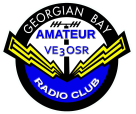
+- GBARC Forum (https://www.gbarc.ca/ForumBB)
+-- Forum: Amateur Radio (https://www.gbarc.ca/ForumBB/forumdisplay.php?fid=5)
+--- Forum: Builders (https://www.gbarc.ca/ForumBB/forumdisplay.php?fid=19)
+---- Forum: Antennas (https://www.gbarc.ca/ForumBB/forumdisplay.php?fid=12)
+---- Thread: 80m End Fed Half Wave Antenna (/showthread.php?tid=156)
80m End Fed Half Wave Antenna - VA3KOT John - 2020-08-09
The End Fed Half Wave (EFHW) antenna is very popular for portable use. It is a very simple antenna that is easy to erect, very lightweight and easy to carry during pedestrian mobile operations. I use one for my /pm ops and have set it up in several provincial park campgrounds. I also use an EFHW at my home QTH. It does not require a counterpoise or radials because the very high feedpoint impedance results in very small common mode currents that are easily dissipated in a few feet of coax or a good ground stake at the feedpoint.
There are a couple of challenges that have to be overcome. The first is the very high feedpoint impedance. That impedance can be several thousand ohms. In order to match it to a 50 ohm coax a 49:1 or sometimes 64:1 toroidal transformer is needed. Fortunately, it is very easy to build such a transformer using a type 43 ferrite toroid (I order FT240-43 cores from Mouser Electronics in Kitchener, Ontario) with either a 14:2 or 16:2 turns ratio.
The second issue is that a half-wave on 80m is 132ft long and may not fit in the available space. Provincial park campsites are typically much shorter than that. This problem is compounded by the need to run the coax at 90 degrees away from the feed point (otherwise a return current is induced in the coax braid). A solution is to shorten the antenna using a coil part way along the wire. But, how much inductance is needed and by how much can we shorten the wire?
I worked out a simple answer to that question. An EFHW antenna also works on harmonics of its fundamental frequency. I built mine for 80m (for the club net Wednesday evenings on 3783KHz) but I also use it on 40m and 20m. The length of a quarter wave antenna on 80m is 66 feet which is also a full wavelength on 20m and a half wave on 40m. If we place our coil at 66 feet from the feed point the rest of the antenna must then be electrically equivalent to another quarter wave on 80m.
Now we can simply use an online calculator to determine the inductance of the coil for any desired length of wire (L2 in the accompanying diagram). There are several sites available that will calculate the inductance for either a loaded dipole or a loaded quarter-wave vertical antenna. I found it was necessary to trim the antenna length for resonance in the part of the band required. Beware, a loaded antenna has a high Q which means pruning must be done in small increments. It also means the bandwidth is narrow and a tuner must be used outside the design frequency range.
My 80m EFHW antenna for camping and general portable use is only 75 feet long with a coil of 113 microhenries. Compare that with a full size 80m EFHW at 132 feet long! It actually fits into an even smaller space by erecting it as a sloper or inverted-V antenna. At home I have a little more space available so I use a coil of 37 microhenries for an overall length of about 86 feet.
By the way, it helps to have an inductance meter to directly measure coils. I wind my coils on random pieces of scrap plastic tube and determine the required number of turns by intelligent guesswork and trial and error!
John, VA3KOT